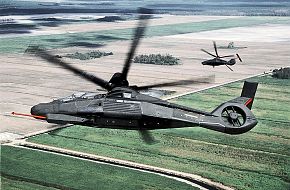

The helicopter had proven to be far heavier than anticipated So heavy, in fact, that some wondered if the stealth helicopter would even get off the ground with its intended weapons payload. The Comanche was truly forward-reaching in its capabilities, but as is so often the case with first-of-its-kind platforms, that reach came with a long list of cost overruns and technological setbacks. The stealth helicopter had been envisioned as a necessary weapon amid the constant defense posturing of the Cold War, but without the looming threat of a technologically capable geopolitical boogeyman, the Comanche began to look more like a pile of problems, rather than solutions. The first Comanche prototype took to the skies in January of 1996, five years after the dissolution of the Soviet Union. With a top speed just shy of 200 miles per hour and enough acrobatic prowess to nearly pull off loop-de-loops, the Comanche was fast, agile, and powerful… but by the time the first two Comanche prototypes were flying, it was also widely seen as unnecessary.

The RAH-66 Comanche’s air-to-air credibility was further bolstered by the platform’s speed and agility. Once the Comanche spotted a target, a laser could be used to lock on for its onboard weapons systems. It was equipped with a long-range Forward-Looking Infrared Sensor to help spot targets, as well as an optional Longbow radar that could be mounted above the rotors to allow the pilot to peak just the radar over hills or buildings–giving the crew important situational awareness of the battlefield ahead while limiting exposure of the rotorcraft itself. The pilot and weapons officer onboard would have utilized a combination of cockpit displays and helmet-mounted systems similar to the more advanced heads up and augmented reality displays found in today’s advanced stealth aircraft like the F-35 Joint Strike Fighter. Again, with air superiority established, an additional 16 Stinger missiles could be mounted on external pylons. However, if the Comanche was sent out to hunt for other attack and reconnaissance helicopters behind enemy lines, it could wreak havoc with 12 AIM-92 Stinger air-to-air missiles. If air superiority had been established and stealth was no longer a pressing concern, additional external pylons could carry eight more Hellfires. Like the stealth fighters to come, the Comanche limited its radar cross-section by carrying its weapons internally, including a retractable 20-millimeter XM301 Gatling cannon and space inside the weapons bays for six Hellfire missiles. The stealth helicopter was expected to engage both ground and air targets in a combat zone, and its munitions reflected that goal. With the Comanche’s stealth technology spoken for, next came the armament. While the rotorcraft could still be heard as it approached, that reduced signature would mean enemy combatants would have less time to prepare before the Comanche closed in on them. The Comanche helicopter was also said to produce just half the noise of a traditional helicopter. It wasn’t just tough to spot on radar or hit with heat-seeking missiles either. The result of all this technology was a stealth helicopter said to have a radar cross-section that was 250 times smaller than the OH-58 Kiowa helicopter it would replace, along with an infrared signature reduced by a whopping 75%.
#Rah 66 comanche full#
Finally, a full suite of radar warning systems, electronic warfare systems, and chaff and flare dispensers would help keep the RAH-66’s crew safe while they rode behind Kevlar and graphite armor plating that could withstand direct hits from heavy machine gunfire. Its specially designed rotor blades were canted downward to reduce the amount of noise the helicopter made in flight. The stealth helicopter also managed engine exhaust by funneling it through its shrouded tail section, reducing its infrared (or heat) signature to further limit detection. Those surfaces themselves were made out of radar-absorbing composite materials to further reduce the RAH-66’s radar signature. The Boeing–Sikorsky team quickly set about building the program’s first two prototypes, leveraging the sort of angular radar-reflecting surfaces that gave the Nighthawk its enigmatic visual profile. Most importantly, the RAH-66 needed to be more survivable than the Army’s existing scout helicopters in highly contested airspace, which meant the new Comanche helicopter would need to borrow design elements from existing fixed-wing stealth platforms like the F-117 Nighthawk to defeat air defense systems and missiles fired from other helicopters. In order to meet the Army’s demands, the Comanche would need to be able to engage lightly armored targets as well as identify tougher ones for engagement from more powerful AH-64 Apaches.


 0 kommentar(er)
0 kommentar(er)
